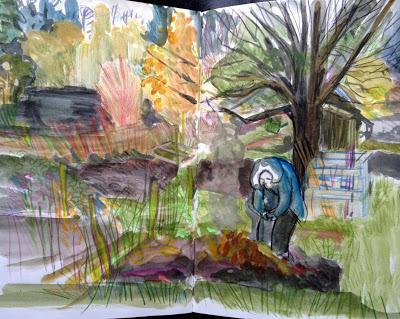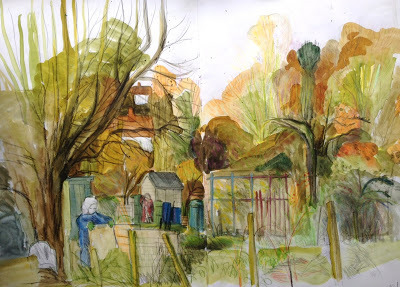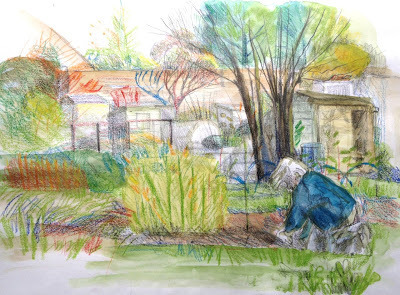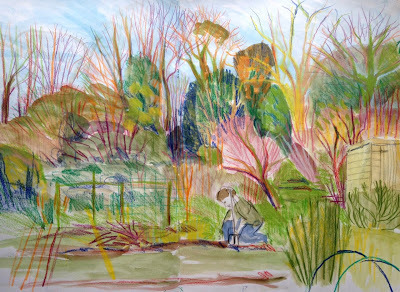Ideas Composting by Jane Clarke
Like the best compost, ideas need time to ripen and mature. Here's a quick guide to ideas composting, with thanks to www.recyclenow.com whose tips
(in italics)
I have stolen and commented on. The wonderful allotment sketches are from Julia Woolf’s sketchbook.

1. Find the right site. Choose a place where you can easily add ingredients to the bin and get the compost out.
The type of bin may vary:The Brain Bin – tends to overflow and can be difficult to access on occasion.The Computer Bin – ditto.The Cloud Bin - ditto.
The Notebook Bin – ditto, and you will need more than one.

2. A dd the right ingredients …everything from vegetable and fruit peelings to teabags, toilet roll tubes, cereal boxes and eggshells….
Add words and pictures of anything and everything that interests you.
3. Fill it up A 50/50 mix of greens and browns is the perfect recipe...
A 50/50 mix of tea/coffee and chocolate is the perfect recipe for good composting. The occasional glass of wine won’t do any harm but too much may damage the contents of your bin.
4. Wait a while. It takes between nine and twelve months for your compost to become ready for use
Sounds about right. Glance in your bin occasionally, but get on with tending to other things.

5. Ready to use Once your compost has turned into a crumbly, dark material, resembling thick, moist soil and gives off an earthy, fresh aroma, you know it’s ready to use.
Your ideas have mingled and matured into something that feels right - and hopefully smells fresh, too!
6. Removing the compost Scoop out the fresh compost with a garden fork, spade or trowel.
Pen, pencils, paint or keyboard may also be used.
7. Use it. Don’t worry if your compost looks a little lumpy with twigs and bits of eggshell – this is perfectly normal.
Phew!
Thanks www.recyclenow.com. The next tip is mine:
8. Nurture what grows in it.

Among the weeds, something is budding that has the potential to grow into something extraordinary...
Jane first heard the word ‘composting’ in this context from her agent Celia Catchpole, and thought it summed up the process perfectly. Jane's website Jane's facebook author page Julia Woolf did the sketches in very cold and sometimes windy conditions, but loved every minute. She says ‘The allotment’s a very special (sort of hidden) place, like the secret garden.’ Julia's facebook illustrator page

1. Find the right site. Choose a place where you can easily add ingredients to the bin and get the compost out.
The type of bin may vary:The Brain Bin – tends to overflow and can be difficult to access on occasion.The Computer Bin – ditto.The Cloud Bin - ditto.
The Notebook Bin – ditto, and you will need more than one.

2. A dd the right ingredients …everything from vegetable and fruit peelings to teabags, toilet roll tubes, cereal boxes and eggshells….
Add words and pictures of anything and everything that interests you.
3. Fill it up A 50/50 mix of greens and browns is the perfect recipe...
A 50/50 mix of tea/coffee and chocolate is the perfect recipe for good composting. The occasional glass of wine won’t do any harm but too much may damage the contents of your bin.
4. Wait a while. It takes between nine and twelve months for your compost to become ready for use
Sounds about right. Glance in your bin occasionally, but get on with tending to other things.

5. Ready to use Once your compost has turned into a crumbly, dark material, resembling thick, moist soil and gives off an earthy, fresh aroma, you know it’s ready to use.
Your ideas have mingled and matured into something that feels right - and hopefully smells fresh, too!
6. Removing the compost Scoop out the fresh compost with a garden fork, spade or trowel.
Pen, pencils, paint or keyboard may also be used.
7. Use it. Don’t worry if your compost looks a little lumpy with twigs and bits of eggshell – this is perfectly normal.
Phew!
Thanks www.recyclenow.com. The next tip is mine:
8. Nurture what grows in it.

Among the weeds, something is budding that has the potential to grow into something extraordinary...
Jane first heard the word ‘composting’ in this context from her agent Celia Catchpole, and thought it summed up the process perfectly. Jane's website Jane's facebook author page Julia Woolf did the sketches in very cold and sometimes windy conditions, but loved every minute. She says ‘The allotment’s a very special (sort of hidden) place, like the secret garden.’ Julia's facebook illustrator page
Published on March 10, 2013 23:00
No comments have been added yet.



